Diagnosis and management of transient ischemic attacks in primary care: a systematic review
Priyanka Bose 1 , Andrew Wilson 1 , Amit Mistri 11 University of Leicester, Health Sciences Centre for Medicine, Leicester, UK
Correspondence to: Priyanka Bose, University of Leicester, Health Sciences Centre for Medicine (Floor 3, Room 3.06), 15 Lancaster Road, Leicester LE1 7HA 0116 252 5449, UK. Email: pb274@le.ac.uk
Journal of Primary Health Care 9(2) 114-130 https://doi.org/10.1071/HC17003
Published: 30 June 2017
Journal Compilation © Royal New Zealand College of General Practitioners 2017.
This is an open access article licensed under a Creative Commons Attribution-NonCommercial-NoDerivatives 4.0 International License.
Abstract
INTRODUCTION: Many patients who suffer a transient ischaemic attack (TIA) present to their general practitioner (GP). Early identification and treatment reduces the risk of subsequent stroke, disability and mortality.
AIM: To review the accuracy of TIA diagnosis in primary care, immediate management and interventions to assist GPs with the condition.
METHODS: This study included the search of Medline, Embase, Web of Science and Scopus databases (1995–2015). Relevant titles and abstracts were obtained using structured criteria (diagnosis, immediate management or intervention of TIAs in primary care), with full review and data extraction for eligible publications.
RESULTS: Most studies found limitations in GPs’ knowledge and ability to diagnose TIAs to varying extent over time and between countries. GPs tended to over-interpret non-specific symptoms (e.g. isolated vertigo) when considering a TIA diagnosis. Reported referral behaviour varied between countries, with some favouring admission and others preferring outpatient management. Consistent under-referral and under-use of effective medication was reported. However, GPs may refer some patients to exclude rather than confirm a final diagnosis. This, alongside evidence of under-referral, suggests the need for education and decision support tools to enhance referral patterns. Intervention studies suggested that electronic decision support may increase referrals and timely management.
CONCLUSION: This review revealed deficiencies in knowledge and clinical practice, and identified potential avenues to addressing these. Issues for future research were also identified.
KEYWORDS: TIA; diagnosis; management; primary care; systematic review
| WHAT GAP THIS FILLS |
| What is already known: Patients suspected of suffering from a TIA are at increased risk of recurrent stroke, and are therefore recognised as medical emergencies requiring urgent evaluation and treatment to reduce the risk of recurrent stroke. Several studies have shown GPs find it difficult to diagnose and manage suspected TIA patients. |
| What this study adds: This is the first systematic review to synthesise the literature on the diagnosis and management of TIA in primary care and to obtain a comprehensive account of current knowledge on the topic. It confirms that GPs have difficulties making the diagnosis and that many patients who could benefit from specialist assessment are not referred. Conversely, only approximately half of patients referred to specialist clinics have the diagnosis confirmed. There is evidence that electronic decision support may improve referral practices. |
Introduction
Transient ischaemic attacks (TIAs) are defined as temporary episodes of focal brain dysfunction of presumed vascular aetiology, lasting <24 h, with no evidence of cerebral infarction.1 Several conditions may mimic a TIA, including migraine, partial seizure, vestibular disorders, syncope, intracranial lesions and psychogenic illness.2
Precise estimates of TIA incidence are difficult to determine, mainly due to the varying criteria used to identify a TIA. Despite this, many studies have attempted to provide reliable data on the true incidence of TIA in several countries. The annual incidence of TIA in the UK is estimated at 0.51 per 1000 population,3 0.80 in Spain,4 0.37–1.1 in the United States (US)5 and 0.40 in New Zealand.6
Accurate diagnosis is important, as the early identification and treatment of TIA substantially reduces patients’ risk of subsequent stroke and consequent disability and mortality.7 Additionally, in France, it was reported that early assessment and management of TIA and minor stroke resulted in ~80% reduction of recurrent stroke at 3 months from initial TIA.8
In England and Wales, the National Institute of Health and Care Excellence guidelines recommend that TIA patients at high risk of stroke should be seen within 24 h, and lower risk cases within a week. New Zealand guidelines also recommend that patients at high stroke risk should be assessed by a specialist and all investigations completed within 24 h.9 The European guidelines recommend that patients with suspected TIA should be referred without delay (preferably within 48 h) to a TIA clinic or to a stroke unit where expert evaluation and immediate treatment can be provided.10
In Italy, timely hospital referral of a recent (within 1 week) TIA is advised, and hospital admission is generally recommended if duration of symptoms is >1 h.11 However, despite the establishment of ‘rapid access’ clinics, these targets are not being achieved12 due to the lack of capacity for clinics to assess the high number of referred patients, over half of whom are eventually confirmed not to have had a stroke or TIA.2,13 This suggests that general practitioners (GPs) could be more selective when referring patients to specialist services.14
There is some evidence that GPs may under-use medication such as aspirin, which could reduce the early risk of stroke.15 Furthermore, under-use of medication (aspirin and statins) is an issue associated with most cardiovascular health-related problems in New Zealand, as prescribing often does not appear to be guideline-based.16 A comparison of European and Japanese guidelines found that recommended doses of antiplatelet medicines, especially aspirin and ticlopidine, are lower in Japan.17
The objectives for this study were, therefore, to review the diagnostic accuracy of TIA in primary care, review immediate management (including referral and medication) and identify interventions to assist GPs in the diagnosis and management of TIA.
Methods
Search strategy
Medline, Embase, Web of Science and Scopus databases were searched in September 2015. Search strategies were customised for each database (Appendix 1, available as Supplementary Materials at journal’s website). Both medical subject headings (MeSH) and text words were used as search terms. Additional studies were identified by searching the references of included studies. The key terms were ‘TIA’, ‘TNA’ (transient neurological attack), ‘general practitioner’ and ‘primary care’. Additional search terms were included to ensure that the search was sufficiently sensitive (Appendix 2, available as Supplementary material). The search was limited to the past 20 years (1995–2015) to exclude out-of-date practices and acknowledge rapid advances in TIA management (Appendix 2, available as Supplementary material).
Inclusion and exclusion criteria
Published full-text, peer-reviewed journal articles reporting empirical studies and systematic reviews were included. There was no restriction on language or study design.
Exclusion criteria included papers restricted to stroke and long-term management, as well as editorials, letters, opinion pieces, conference abstracts, case reports and non-systematic reviews.
Participants were GPs, family doctors, family physicians (subsequently referred to as GPs) and patients with TIA presenting to primary care. Exclusions included paramedics, emergency department and secondary care physicians, and studies of long-term management or secondary prevention.
Data extraction
The titles and abstracts of all publications were read and the eligibility criteria were applied by PB and AW. If titles and abstracts had insufficient information to apply the criteria, the full text was obtained. The search process is shown in Figure 1.
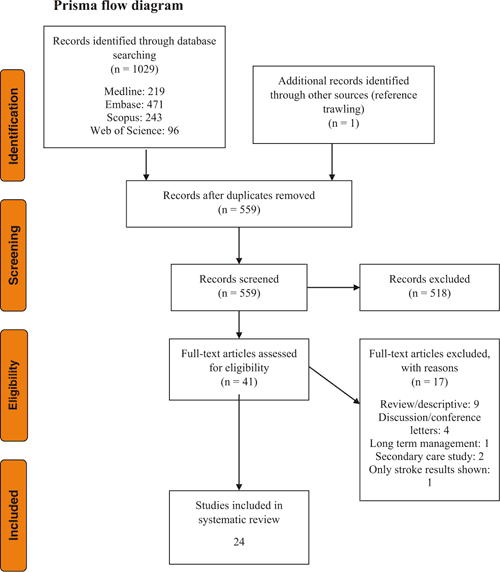
|
A standard data extraction form was used (Appendix 3, available as Supplementary material). Studies used a range of methods and instruments so meta-analysis was inappropriate and a narrative synthesis was undertaken.
Quality assessment
The methodological quality of each study was assessed using the Mixed Methods Appraisal Tool18 (Appendix 4, available as Supplementary material). Two review authors assessed the methodological quality independently and resolved disagreements through discussion or with arbitration by a third author. The protocol was registered on Prospero on 08 January 2016 (registration number: CRD42016032995).
Results
Of the 1029 papers identified, 24 were included, as shown in Figure 1. Table 1 shows the countries where the research was conducted, and Figure 1 shows the reasons for excluding papers. Included studies were categorised according to the categories shown in Box 1: knowledge-based studies (Table 2), actual practice studies (Table 3) and intervention studies (Table 4). There were three management subcategories: diagnosis and prognosis (4 studies), recognition of urgency (16 studies) and immediate prescription or preventive medication (6 studies). Several studies contributed to more than one subcategory (Appendix 5, available as Supplementary material).
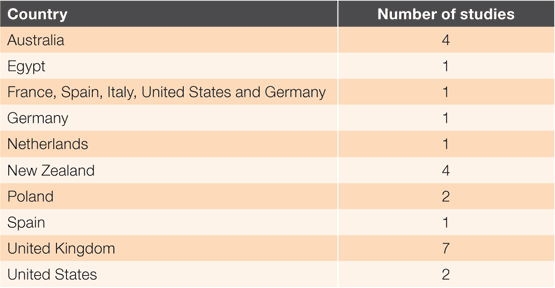
|
| Box 1. Three main categories of research | ||||||
| ||||||
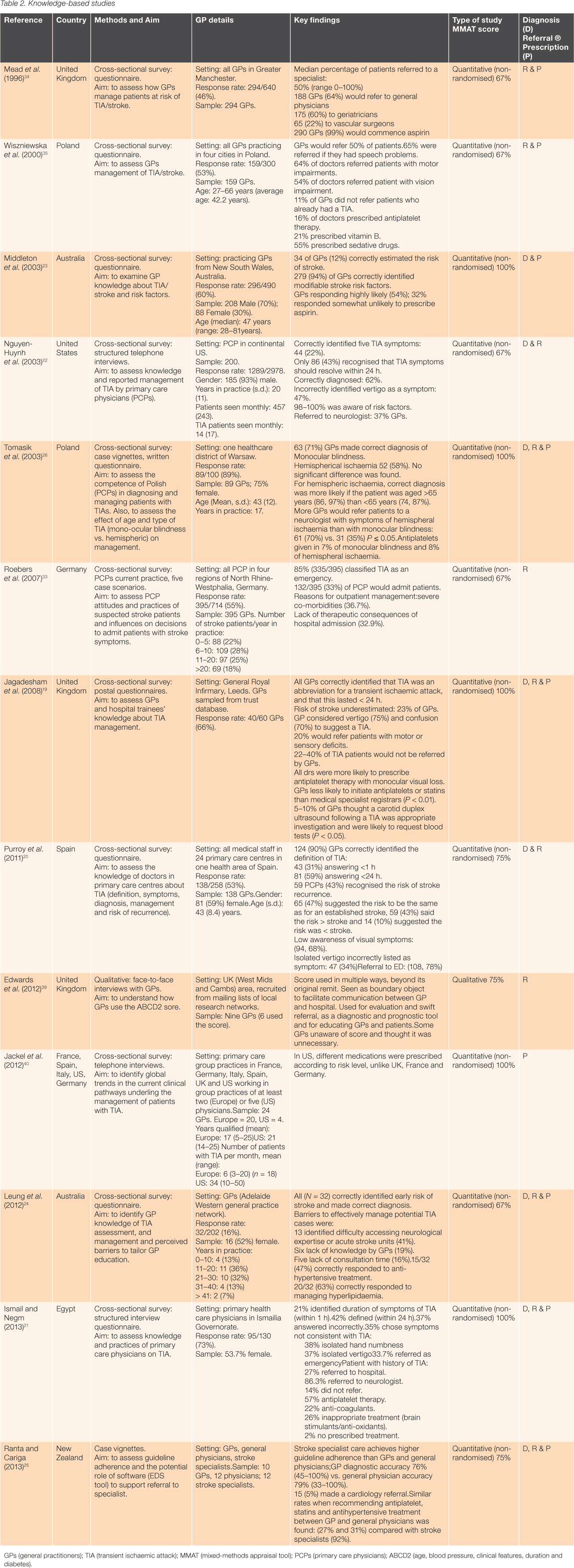
|
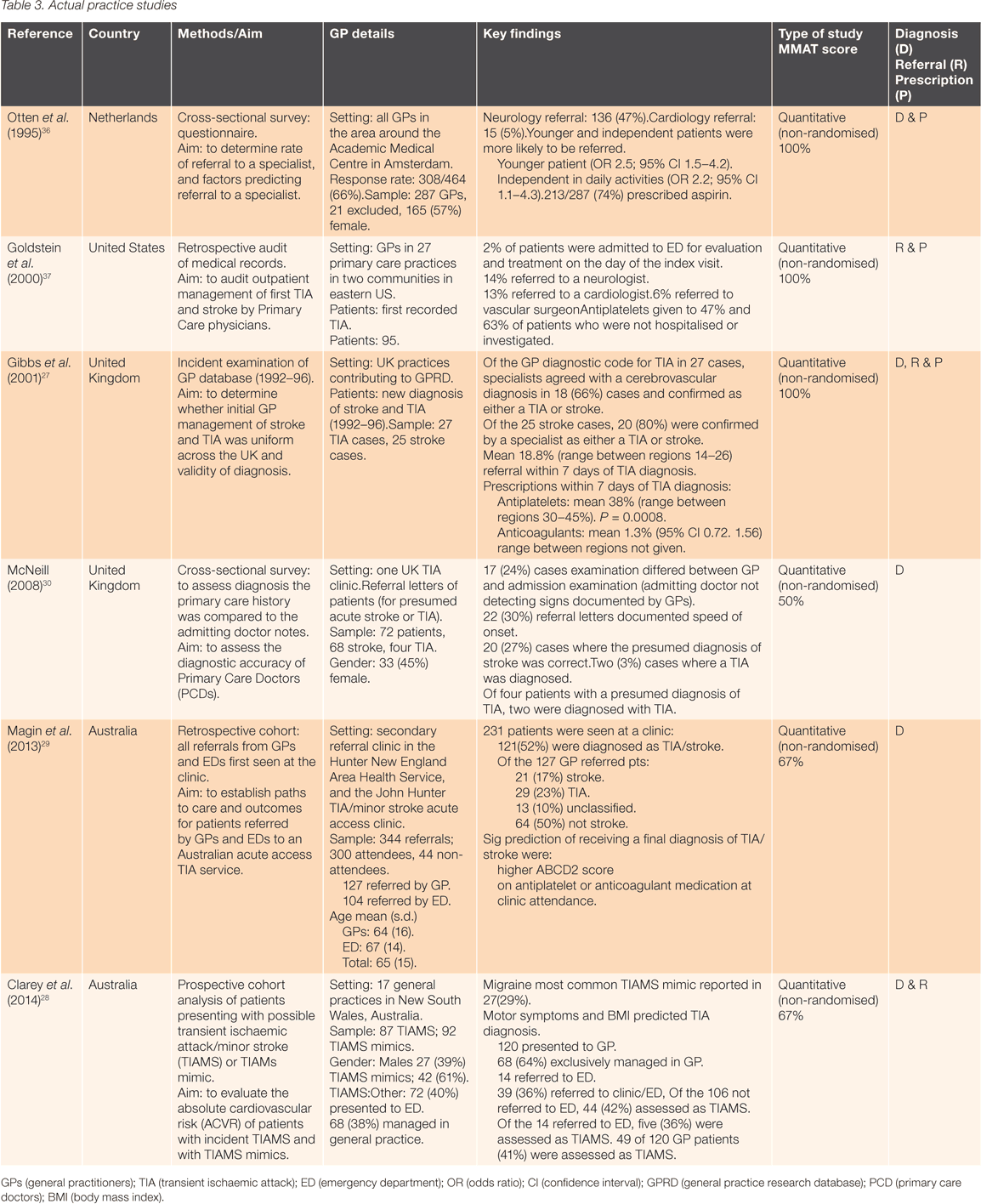
|
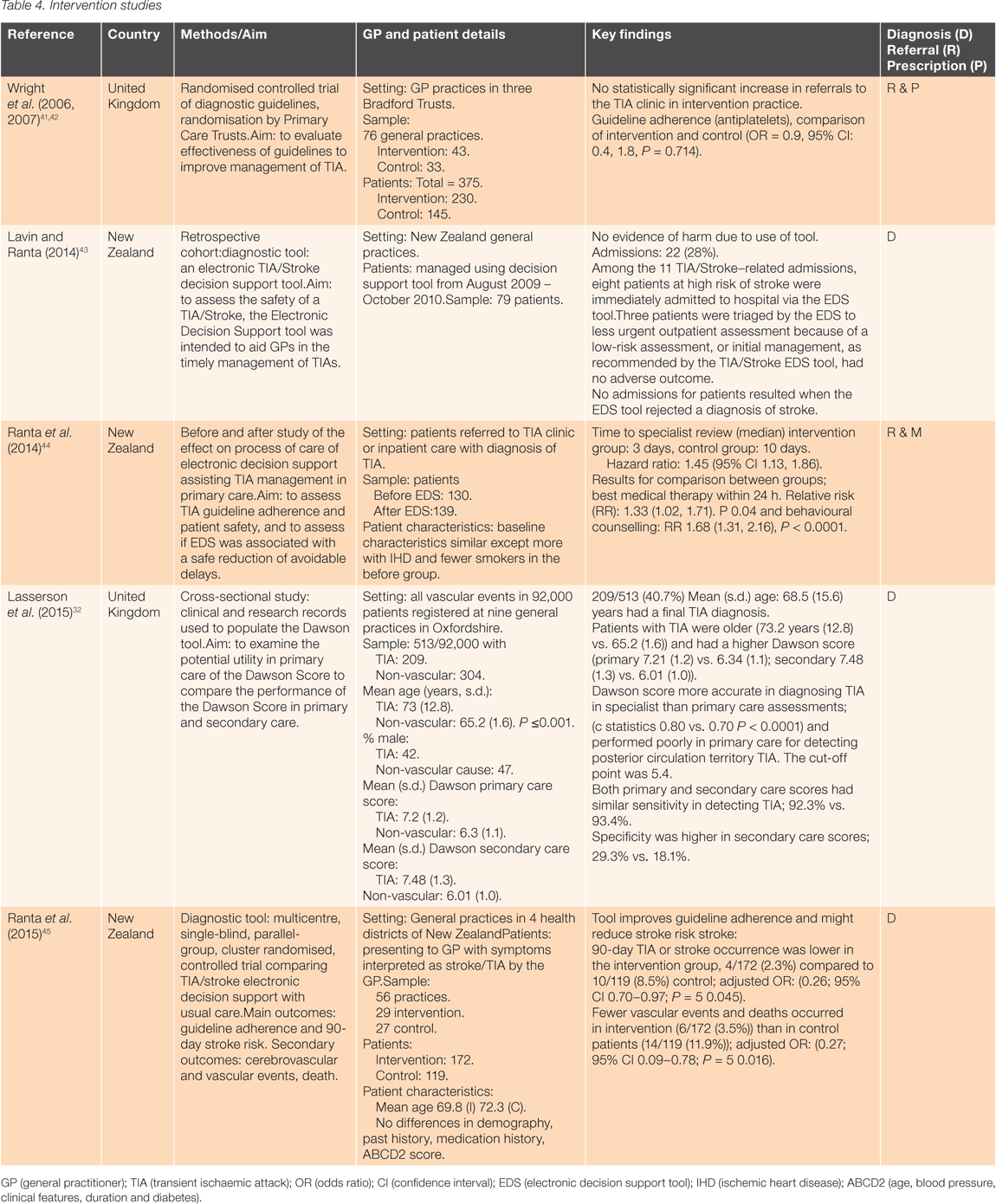
|
Diagnosis and prognosis
Data from four studies indicated variable awareness among GPs about the traditional definition of TIA symptom duration (<24 h): 100% (40/40 GPs) in the UK,19 90% (124/138) in Spain20 and 63% (60/95) in Egypt.21 In the US, 57% (114/200) thought symptoms of longer duration were compatible with TIA diagnosis.22
There was generally high awareness that TIA was a risk factor for a subsequent stroke,23 but variable knowledge of the magnitude of risk.20,24 Diagnostic accuracy was also variable. In surveys presenting typical cases, the proportion correctly identified with TIA was 62% in 2003,22 76% in 201325 and 100% in 2008 and 2012.19,24 GPs were more likely to diagnose TIA in patients with known risk factors and in the elderly.26 Several studies found that GPs tended to consider a diagnosis of TIA when symptoms were non-specific. For example, isolated vertigo was considered a possible symptom by 75% (30/40) of GPs in the UK,19 47% (94/200) in the US,22 37% (35/95) in Egypt21 and 34% (47/138) in Spain.20
Real world accuracy of TIA diagnosis is difficult to assess. The most direct assessment used a UK GP database in 2001 to identify patients with a new diagnosis of TIA.27 In a sample of 27 cases, the medical record was reviewed by a specialist, who diagnosed TIA in 13 (48%) and stroke in five (19%), giving a cerebrovascular diagnosis in 18 (67%). The most common non-TIA diagnoses were cardiac dysrhythmia, postural hypotension and ‘psychological’. In a 2014 Australian study, 120 GP-diagnosed TIA cases were reviewed by an expert panel, who concluded that 49 (41%) had a cerebrovascular diagnosis; the most common other diagnosis being migraine. This study also found that assessment of absolute cardiovascular risk did not improve diagnostic accuracy.28
Three studies examined the proportion of patients referred to TIA (or similar) clinics who had a diagnosis of TIA or stroke confirmed. The GP database study found that only 19% of patients with new TIA diagnoses were referred in 2001.27 In an Australian study of 127 patients referred with possible TIA, 23% were confirmed with TIA, 17% with stroke, 50% non-stroke and 10% were unclassified.29 In a smaller UK study, a diagnosis of TIA was confirmed in two of four patients.30 As part of assessing the Dawson score,31 all referrals to a vascular clinic from nine practices in the UK were examined and 41% (209/513) had a diagnosis of TIA confirmed.32
Recognition of urgency
Case vignettes and surveys reported variation in admitting patients with TIA as medical emergencies. In Spain, 78% (107/138) of GPs would send TIA patients to hospital.20 In Egypt, 34% (32/95) of GPs referred TIA patients as emergencies, while 27% (26/95) referred patients to hospital if they had a TIA history.21 In Germany, 85% (335/395) of GPs classified TIA as an emergency and 33% (132/395) would admit patients.33 In the UK, a study using vignettes found that GPs would not refer 22–40% of TIA cases.25 An earlier UK survey found that median reported referral rates were 50%, with substantial variation between GPs.34 Similar rates were reported in Poland.35 Several surveys found that referral decisions were affected by symptom and patient characteristics, especially age.19,26,35,36
Two studies surveyed reasons for outpatient management and barriers to admitting stroke or TIA patients. In a German survey, 33% (133/395) of GPs chose outpatient management because of perceived lack of therapeutic benefit from hospital admissions, and 37% (147/395) because of severe co-morbidities in patients.33 In Australia, 19% (6/32) of GPs suggested lack of knowledge and 16% (5/32) lack of time in consultations as barriers to referral.24
The specialist to whom patients with TIA were referred differed between countries. In the Netherlands, most GPs would refer to a neurologist,36 in the US and New Zealand a cardiologist or neurologist,22,25,37 and in the UK, a physician, geriatrician or vascular surgeon.34
A qualitative study in the UK examined GPs’ views of the ABCD2 score in influencing referrals.38 Although GPs liked the score as a ‘substantial means to navigate the referral system’,39 the score was used beyond its original remit (as a diagnostic, prognostic and educational tool for GPs and patients) and has been criticised with regards to disagreement between referred and specialist ABCD2 scores.39
Only two studies examined actual referrals from general practice. An Australian cohort study found that 36% of TIA suspects were referred to an emergency department or clinic.28 The UK GP database study (conducted from 1992 to 1996) showed that only 19% of TIA cases were referred.27
Immediate prescription or preventive medication
In the US, GPs prescribe according to patients’ risk level, unlike in the UK, France and Germany.40 In the UK, GPs were more likely to prescribe anti-platelet therapy with monocular visual loss than other symptoms (P = 0.03).19 Patient factors associated with medication use were: age over 65 years; antiplatelet use; 7% of cases of monocular blindness versus 8% of hemispherical ischaemia; and prescription of peripheral vasodilators.26
Studies of actual practice confirmed under-use of effective medication. In the US, an audit of medical records found 47% of patients with TIA who were not hospitalised or with no diagnostic test performed were prescribed antiplatelet therapy.37 In the Netherlands, a study asking GPs how they managed their last patient with TIA found 74% received aspirin,36 and a UK database study found that prescription rates within 7 days of onset of TIA were 38% for antiplatelet and 1.3% for anticoagulants.27 Further details of medication use by country are shown in Table 5.
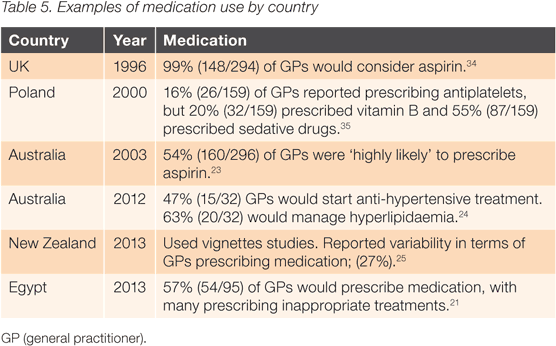
|
Intervention studies
A UK trial included 76 general practices examining the effect of guidelines to manage TIAs.41,42 It found that guidelines led to a non-statistically significant increase in referrals of patients with confirmed TIA, but had no effect on prescribing antiplatelets (odds ratio (OR) 0.9 (95% CI 0.4, 1.8) P = 0.714).41,42
Three studies examined the electronic decision support that aids GPs to accurately diagnose and manage TIA and stroke patients in accordance with the New Zealand guidelines.43–45
A prospective study of the effect on process of care following the implementation of electronic decision support reported significant increases in the rate of initiating best medical therapy and behavioural counselling; for example, smoking cessation, diet, exercise and driving.44 The study also reported that the median time to a specialist review was 3 days (intervention) and 4 days (control). The main trial reported that the decision support tool improved guideline adherence and may reduce risk of a subsequent event (stroke, TIA, vascular event or death).45 In an audit of the electronic decision support tool, no safety issues were found.43
The Dawson score was developed in secondary care and is the only published diagnostic tool for diagnosing TIA.31 It includes nine variables: age, history of stroke or TIA, and presence of seven clinical features (headache, loss of consciousness, seizure, diplopia, speech disturbance, unilateral facial and limb weakness). Its potential for use in primary care was tested in patients referred to a TIA clinic by comparing the score derived for primary care data with the score derived from hospital clinic data.32 The score had greater accuracy in diagnosing TIA in specialist assessments than in primary care assessments. Both primary and secondary care scores had similar sensitivity in detecting a TIA (92.3% vs. 93.4%), but low specificity (29.3% vs. 18.1%). The authors concluded that the score was of limited use in primary care, and that there was a need for a score derived from primary care data.
Discussion
This systematic review synthesises the evidence on the diagnosis and management of TIA in primary care. Most studies demonstrated significant knowledge gaps for TIA, although to varying degrees. Overall, there was no clear evidence of changes in diagnosis and management over time in the period examined, but the number of comparable studies was small. Most studies highlighted a need for more education on the specific symptoms of TIA. There is also consistent evidence that many patients who could benefit from specialist referral are not referred, and that only approximately half of referred patients have the TIA diagnosis confirmed. Further studies on decision support tools are needed to improve diagnostic and referral practices.
Diagnosis
Most studies found limitations in GPs’ knowledge and abilities to diagnose TIA. Only one study attempted to validate all TIA diagnoses made by GPs, and this suggested the diagnosis was correct in approximately two-thirds of cases (although diagnostic agreement between specialists is not perfect).46 One reason for over-diagnosis, suggested by questionnaires and case vignette studies, is that GPs tend to put emphasis on non-specific symptoms such as isolated vertigo.19–22 It is difficult to infer much about diagnostic accuracy from studies examining patients referred to TIA clinics due to selection bias (inclusion of patients with higher clinical suspicion of TIA, and exclusion of patients not referred). Attempts to improve GP diagnosis have been limited. The Dawson score appears to be insufficiently specific, and although the electronic decision support tool improved management, its impact on diagnosis has not been reported.
Referral and management
Unsurprisingly, reported referral behaviour varied between countries, with no consistency in management strategies; some favour admission of high-risk cases20,21,33 and others advocate outpatient management.24,33 There is consistent evidence of under-referral in studies of reported and actual practice in Australia, United States, New Zealand, Netherlands and the UK. Only two studies examined actual referral rates. In the UK, this was found to be only 19%, but the study was conducted in the 1990s when the benefits of specialist intervention were not well recognised. In a smaller Australian study, 36% of TIA suspects were referred. In part, this apparently low rate could be because GPs have direct access to imaging, so management can be optimised without specialist assessment. More research is needed to investigate whether under-referral remains a problem in current practice.
Conversely, there is consistent evidence that approximately half of patients who are referred have a cerebrovascular diagnosis confirmed, and that in some countries, this militates against services reaching their target for assessing patients promptly. GPs may well refer some patients to exclude rather than confirm a putative diagnosis, but this finding, together with evidence of under-referral, emphasises the need for education and decision support tools to optimise referral patterns. The intervention studies included in this review suggested that electronic decision support may increase referrals and timely management.
Methodological issues
Most of the reviewed studies used questionnaires or case vignettes to examine GP practice. There are inherent limitations to this approach, including the validity of questionnaires and whether responses reflect actual practice. In the quality assessment tool we used, an adequate survey response rate was defined as ≥60%, which was achieved in five studies. The reason for low response rates in studies using telephone interviews may be due to the time-consuming method, in comparison to postal questionnaires. The overall response rates were higher in studies using case vignettes, suggesting that this approach is more acceptable than ‘exam style’ questions. Low response rates increase the risk of bias. Previous research has shown that in GP surveys, non-responders are more likely to be older, more experienced, solo practitioners, and have fewer qualifications than responders.47 It is likely that responders to surveys about TIA are more interested and have a higher awareness of the topic, which implies that our results overestimate GP knowledge and good practice.
A comprehensive search strategy including all languages and countries was applied. Papers from several countries were included, providing insight from different health systems. Additionally, both qualitative and qualitative study design was considered in the search strategy, and a quality tool applicable to all study designs was used.
A limitation was that the search terms focused on diagnosis. Thus, some papers about management, which did not include diagnosis, may have been missed. Additionally, it was difficult to differentiate between stroke and TIA in some studies that included both. However, both TIA and minor strokes have similar prognosis and management strategies, so it is reasonable to consider these together. Finally, some studies were old and predated current guidelines so may not reflect current levels of knowledge and practice. Perhaps future reviews should consider a shorter time interval in accordance with the rapid changes in knowledge and management of TIA.
Future research
This study has identified a need for further education and practical guidelines for GPs to improve knowledge and practice with respect to diagnosis, management and referral pathways. Although ABCD2 is often perceived as a tool to aid diagnosis, it was designed as a prognostic tool only. Its diagnostic utility has been studied and found inadequate to guide referral decisions.32 Recent guidance in the UK now excludes risk stratification using this tool (updated in 2017).12 Further work is needed to explore the potential utility of electronic decision support systems, building on initial work undertaken in New Zealand. This should include larger sample sizes and explore utility in other health systems.
A limitation of several studies that observed practice is potential selection bias. Therefore, there is a need to examine larger and more representative samples from primary care, which are now possible using routine GP databases.
There remains significant potential for the development of diagnostic tools for primary care, which should be derived and validated in primary care. A first step could be further work to assess the performance of the Dawson score using data collected in primary care. Since the completion of this systematic review, the diagnosis of TIA (DOT) score has been developed.48 The relative merits and clinical utility of both scores deserves further prospective study using primary care data.
FUNDING
This work was supported and funded by the University of Leicester and completed as part of a PhD.
ACKNOWLEDGEMENTS
We thank Keith Nockels and Selina Lock, the learning and teaching service librarians at the University of Leicester, who consistently provided insight and expertise in terms of the search strategy that greatly assisted the systematic review research. Prospero registration number: CRD42016032995.
References
[1] World Health Organization. UNAIDS. Prevention of cardiovascular disease. Geneva: World Health Organization; 2007.[2] Bos MJ, Van-Rijn MJE, Witteman JCM, et al. Incidence and prognosis of transient neurological attacks. JAMA. 2007; 298 2877–85.
| Incidence and prognosis of transient neurological attacks.Crossref | GoogleScholarGoogle Scholar | 1:CAS:528:DC%2BD1cXmvFOq&md5=7d71311037e269cc7304f50800a46971CAS |
[3] Intercollegiate Stroke Working Party. National clinical guideline for stroke 2012. [cited 2016 November 15]. Available from: http://bsnr.org.uk/wp-content/uploads/2014/05/national-clinical-guidelines-for-stroke-fourth-edition.pdf
[4] Sempere AP, Duarte J, Cabezas C, et al. Incidence of transient ischemic attacks and minor ischemic strokes in Segovia, Spain. Stroke. 1996; 27 667–71.
| Incidence of transient ischemic attacks and minor ischemic strokes in Segovia, Spain.Crossref | GoogleScholarGoogle Scholar | 1:STN:280:DyaK287ot1CjtA%3D%3D&md5=caf618d4a7dd8770cf3239bd671cb300CAS |
[5] Edlow JA, Kim S, Pelletier AJ, et al. National study on emergency department visits for transient ischemic attack, 1992–2001. Acad Emerg Med. 2006; 13 666–72.
[6] Barber PA, Krishnamurthi R, Parag V, et al. Incidence of transient ischemic attack in Auckland, New Zealand, in 2011 to 2012. Stroke. 2016; 47 2183–8.
| Incidence of transient ischemic attack in Auckland, New Zealand, in 2011 to 2012.Crossref | GoogleScholarGoogle Scholar |
[7] Rothwell PM, Giles MF, Chandratheva A, et al. Effect of urgent treatment of transient ischaemic attack and minor stroke on early recurrent stroke (EXPRESS study): a prospective population-based sequential comparison. Lancet. 2007; 370 1432–42.
| Effect of urgent treatment of transient ischaemic attack and minor stroke on early recurrent stroke (EXPRESS study): a prospective population-based sequential comparison.Crossref | GoogleScholarGoogle Scholar |
[8] Lavallée PC, Meseguer E, Abboud H, et al. A transient ischaemic attack clinic with round-the-clock access (SOS-TIA): feasibility and effects. Lancet Neurol. 2007; 6 953–60.
| A transient ischaemic attack clinic with round-the-clock access (SOS-TIA): feasibility and effects.Crossref | GoogleScholarGoogle Scholar |
[9] Gommans J, Barber P, Fink J. New Zealand guideline for the assessment and management of people with recent transient ischaemic attack. Wellington: Stroke Foundation of New Zealand; 2008.
[10] European Stroke Organisation (ESO) Executive Committee, ESO Writing Committee Guidelines for management of ischaemic stroke and transient ischaemic attack Cerebrovasc Dis. 2008; 25 457–507.
| Guidelines for management of ischaemic stroke and transient ischaemic attackCrossref | GoogleScholarGoogle Scholar |
[11] Prevention S. Italian guidelines for stroke prevention and management: syntheses and recommendations. Milan, Italy: Stroke Prevention and Educational Awareness Diffusion; 2003; 38.
[12] National Collaborating Centre for Chronic Conditions (Great Britain), Royal College of Physicians of London. Stroke: national clinical guideline for diagnosis and initial management of acute stroke and transient ischaemic attack (TIA). City: Royal College of Physicians; 2008 [cited 2017 March 1]. Available from: https://www.nice.org.uk/guidance/cg68/resources/surveillance-report-2017-stroke-and-transient-ischaemic-attack-in-over-16s-diagnosis-and-initial-management-2008-nice-guideline-cg68-4358987103/chapter/Surveillance-decision
[13] Suljic E, Mehicevic A, Gavranovic A. Stroke emergency medical care: initial assessment, risk factors, triage and hospitalization outcome. Mater Sociomed. 2013; 25 83
| Stroke emergency medical care: initial assessment, risk factors, triage and hospitalization outcome.Crossref | GoogleScholarGoogle Scholar |
[14] Noureddine A, Ghandehari K, Taghi Shakeri M. Differentiation of true transient ischemic attack versus transient ischemic attack mimics. Iran J Neurol. 2014; 13 127–30.
[15] Senes S, Penm E. Medicines for cardiovascular health: are they used appropriately? Canberra: Australian Institute of Health and Welfare; 2007.
[16] Hong JB, Kerse N, Scahill S, et al. Use of aspirin and statins for cardiovascular risk reduction in New Zealand: the residential care story. J Prim Health Care. 2009; 1 184–9.
[17] Kern R, Nagayama M, Toyoda K, et al. Comparison of the European and Japanese guidelines for the management of ischemic stroke. Cerebrovasc Dis. 2013; 35 402–18.
| Comparison of the European and Japanese guidelines for the management of ischemic stroke.Crossref | GoogleScholarGoogle Scholar |
[18] Pluye P, Robert E, Cargo M, et al. Proposal: a mixed methods appraisal tool for systematic mixed studies reviews. Montréal: McGill University 2011; 2 1–8.
[19] Jagadesham VP, Aparajita R, Gough MJ. Can the UK guidelines for stroke be effective? Attitudes to the symptoms of a transient ischaemic attack among the general public and doctors. Clin Med. 2008; 8 366–70.
| Can the UK guidelines for stroke be effective? Attitudes to the symptoms of a transient ischaemic attack among the general public and doctors.Crossref | GoogleScholarGoogle Scholar |
[20] Purroy F, Cruz E, Galindo O, et al. Survey of the knowledge and management of transient ischemic attacks among primary care physicians and nurses. Neurologia. 2011; 26 200–7.
| Survey of the knowledge and management of transient ischemic attacks among primary care physicians and nurses.Crossref | GoogleScholarGoogle Scholar | 1:STN:280:DC%2BC38vntVOltQ%3D%3D&md5=b26f1aa88222a287efab2040339d1375CAS |
[21] Ismail MA, Negm ME. A study of knowledge of TIA’s in primary care practice in Ismailia governorate, Egypt. Egypt J Neurol Psychiat Neurosurg. 2013; 50 5–12.
[22] Nguyen-Huynh MN, Fayad P, Gorelick PB, et al. Knowledge and management of transient ischemic attacks among US primary care physicians. Neurology. 2003; 61 1455–6.
| Knowledge and management of transient ischemic attacks among US primary care physicians.Crossref | GoogleScholarGoogle Scholar |
[23] Middleton S, Sharpe D, Harris J, et al. Case scenarios to assess Australian general practitioners’ understanding of stroke diagnosis, management, and prevention. Stroke. 2003; 34 2681–6.
| Case scenarios to assess Australian general practitioners’ understanding of stroke diagnosis, management, and prevention.Crossref | GoogleScholarGoogle Scholar |
[24] Leung ES, Hamilton-Bruce MA, Price C, et al. Transient ischaemic attack (TIA) knowledge in general practice: a cross-sectional study of Western Adelaide general practitioners. BMC Res Notes. 2012; 5 278
| Transient ischaemic attack (TIA) knowledge in general practice: a cross-sectional study of Western Adelaide general practitioners.Crossref | GoogleScholarGoogle Scholar |
[25] Ranta A, Cariga P. Who should manage transient ischemic attacks? A comparison between stroke experts, generalists, and electronic decision support. N Z Med J. 2013; 126 25–31.
[26] Tomasik T, Windak A, Margas G, et al. Transient ischaemic attacks: desired diagnosis and management by Polish primary care physicians. Fam Pract. 2003; 20 464–8.
| Transient ischaemic attacks: desired diagnosis and management by Polish primary care physicians.Crossref | GoogleScholarGoogle Scholar | 1:STN:280:DC%2BD3szntlGrsQ%3D%3D&md5=3e62efdc806a0747cc4f2e5ce07e0b11CAS |
[27] Gibbs RGJ, Newson R, Lawrenson R, et al. Diagnosis and initial management of stroke and transient ischemic attack across UK health regions from 1992 to 1996: experience of a national primary care database. Stroke. 2001; 32 1085–90.
| Diagnosis and initial management of stroke and transient ischemic attack across UK health regions from 1992 to 1996: experience of a national primary care database.Crossref | GoogleScholarGoogle Scholar | 1:STN:280:DC%2BD3MvpsFymug%3D%3D&md5=dfe67da364b92826d25f4c6fcde4bdc3CAS |
[28] Clarey J, Lasserson D, Levi C, et al. Absolute cardiovascular risk and GP decision making in TIA and minor stroke. Fam Pract. 2014; 31 664–9.
| Absolute cardiovascular risk and GP decision making in TIA and minor stroke.Crossref | GoogleScholarGoogle Scholar |
[29] Magin P, Lasserson D, Parsons M, et al. Referral and triage of patients with transient ischemic attacks to an acute access clinic: risk stratification in an Australian setting. Int J Stroke. 2013; 8 81–9.
| Referral and triage of patients with transient ischemic attacks to an acute access clinic: risk stratification in an Australian setting.Crossref | GoogleScholarGoogle Scholar |
[30] McNeill A. How accurate are primary care referral letters for presumed acute stroke? Scott Med J. 2008; 53 11–2.
| How accurate are primary care referral letters for presumed acute stroke?Crossref | GoogleScholarGoogle Scholar | 1:STN:280:DC%2BD1cjotlyisw%3D%3D&md5=0337e7c4a9ebabb293e6395735c01429CAS |
[31] Dawson J, Lamb KE, Quinn TJ, et al. A recognition tool for transient ischaemic attack. QJM. 2009; 102 43–9.
| A recognition tool for transient ischaemic attack.Crossref | GoogleScholarGoogle Scholar | 1:STN:280:DC%2BD1M%2FhvVCquw%3D%3D&md5=aada1d38285e09bb7107986a5b3822f0CAS |
[32] Lasserson DS, Mant D, Richard Hobbs FD, Rothwell PM. Validation of a TIA recognition tool in primary and secondary care: implications for generalizability. Int J Stroke. 2015; 10 692–6.
| Validation of a TIA recognition tool in primary and secondary care: implications for generalizability.Crossref | GoogleScholarGoogle Scholar |
[33] Roebers S, Wagner M, Ritter M, et al. Attitudes and current practice of primary care physicians in acute stroke management. Stroke. 2007; 38 1298–303.
| Attitudes and current practice of primary care physicians in acute stroke management.Crossref | GoogleScholarGoogle Scholar |
[34] Mead GE, Murray H, McCollum CN, et al. How do general practitioners manage patients at risk from stroke? Br J Clin Pract. 1996; 50 426–30.
| 1:STN:280:DyaK2s7ptFOluw%3D%3D&md5=9371d6f4d5f08f94cd3a3061a41afad5CAS |
[35] Wiszniewska M, Swiderski W, Wlodek A, et al. How do general practitioners proceed on initial contact with patients after cerebrovascular ischemia? Neurol Neurochir Pol. 2000; 34 1119–27.
| 1:STN:280:DC%2BD3MzlsFertw%3D%3D&md5=9f20359e95129c46fd032ab7b668bca0CAS |
[36] Otten A, Niño YB, Limburg M, et al. Management of transient ischemic attacks by the general practitioner. Cerebrovasc Dis. 1995; 5 358–61.
| Management of transient ischemic attacks by the general practitioner.Crossref | GoogleScholarGoogle Scholar |
[37] Goldstein LB, Bian J, Samsa G, et al. New transient ischemic attack and stroke: outpatient management by primary care physicians. Arch Intern Med. 2000; 160 2941–6.
| New transient ischemic attack and stroke: outpatient management by primary care physicians.Crossref | GoogleScholarGoogle Scholar | 1:STN:280:DC%2BD3crgt1Wksw%3D%3D&md5=cafe383035e8cf58333938de0dd0a90cCAS |
[38] Johnston SC, Rothwell PM, Nguyen-Huynh MN, et al. Validation and refinement of scores to predict very early stroke risk after transient ischaemic attack. Lancet. 2007; 369 283–92.
| Validation and refinement of scores to predict very early stroke risk after transient ischaemic attack.Crossref | GoogleScholarGoogle Scholar |
[39] Edwards D, Cohn SR, Mavaddat N, et al. Varying uses of the ABCD2 scoring system in primary and secondary care: a qualitative study. BMJ Open. 2012; 2 e001501
| Varying uses of the ABCD2 scoring system in primary and secondary care: a qualitative study.Crossref | GoogleScholarGoogle Scholar |
[40] Jäkel A, Plested M, Chapman A, et al. Management of patients with transient ischemic attack: insight from real-life clinical practice in Europe and the United States. Curr Med Res Opin. 2012; 28 429–37.
| Management of patients with transient ischemic attack: insight from real-life clinical practice in Europe and the United States.Crossref | GoogleScholarGoogle Scholar |
[41] Wright J, Harrison S, McGeorge M, et al. Improving the management and referral of patients with transient ischaemic attacks: a change strategy for a health community. Qual Saf Health Care. 2006; 15 9–12.
| Improving the management and referral of patients with transient ischaemic attacks: a change strategy for a health community.Crossref | GoogleScholarGoogle Scholar | 1:STN:280:DC%2BD28%2FntV2ksw%3D%3D&md5=5b76fb61268a2ec73d60ac888c6f724bCAS |
[42] Wright J, Bibby J, Eastham J, et al. Multifaceted implementation of stroke prevention guidelines in primary care: cluster-randomised evaluation of clinical and cost effectiveness. Qual Saf Health Care. 2007; 16 51–9.
| Multifaceted implementation of stroke prevention guidelines in primary care: cluster-randomised evaluation of clinical and cost effectiveness.Crossref | GoogleScholarGoogle Scholar |
[43] Lavin TL, Ranta A. Transient ischaemic attack/stroke electronic decision support: a 14-month safety audit. J Stroke Cerebrovasc Dis. 2014; 23 267–70.
| Transient ischaemic attack/stroke electronic decision support: a 14-month safety audit.Crossref | GoogleScholarGoogle Scholar |
[44] Ranta A, Yang C, Funnell M, et al. Utility of a primary care based transient ischaemic attack electronic decision support tool: a prospective sequential comparison. BMC Fam Pract. 2014; 15 86
| Utility of a primary care based transient ischaemic attack electronic decision support tool: a prospective sequential comparison.Crossref | GoogleScholarGoogle Scholar |
[45] Ranta A, Dovey S, Weatherall M, et al. Cluster randomized controlled trial of TIA electronic decision support in primary care. Neurology. 2015; 84 1545–51.
| Cluster randomized controlled trial of TIA electronic decision support in primary care.Crossref | GoogleScholarGoogle Scholar |
[46] Kraaijeveld CL, van Gijn J, Schouten HJ, et al. Interobserver agreement for the diagnosis of transient ischemic attacks. Stroke. 1984; 15 723–5.
| Interobserver agreement for the diagnosis of transient ischemic attacks.Crossref | GoogleScholarGoogle Scholar | 1:STN:280:DyaL2c3nsFersw%3D%3D&md5=b26f736f3a24bbaada262aa43a9d1ae8CAS |
[47] McAvoy BR, Kaner EF. General practice postal surveys: a questionnaire too far? BMJ. 1996; 313 732
| General practice postal surveys: a questionnaire too far?Crossref | GoogleScholarGoogle Scholar | 1:STN:280:DyaK28vhs1Kmsw%3D%3D&md5=fa64a1fe4d290082af04d2433c9e25e3CAS |
[48] Dutta D. Diagnosis of TIA (DOT) score–design and validation of a new clinical diagnostic tool for transient ischaemic attack. BMC Neurol. 2016; 16 20
| Diagnosis of TIA (DOT) score–design and validation of a new clinical diagnostic tool for transient ischaemic attack.Crossref | GoogleScholarGoogle Scholar |


